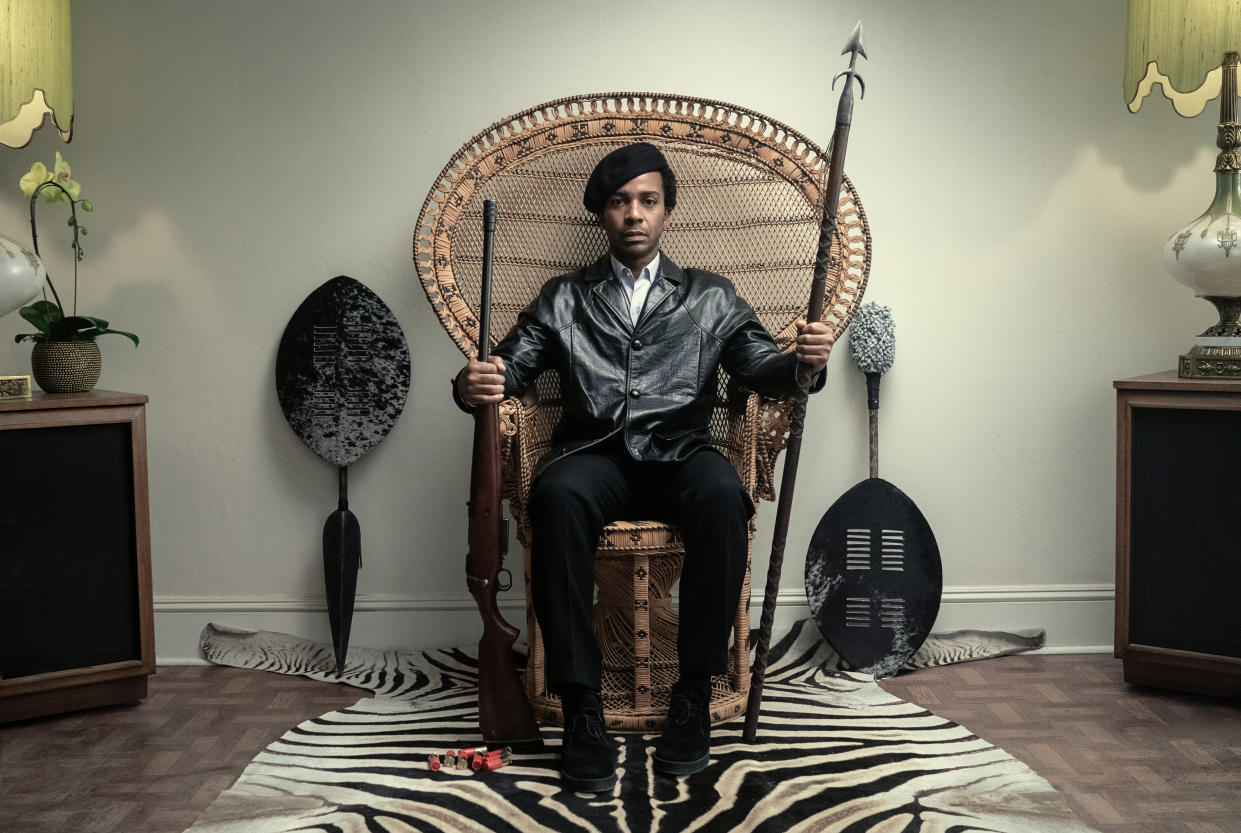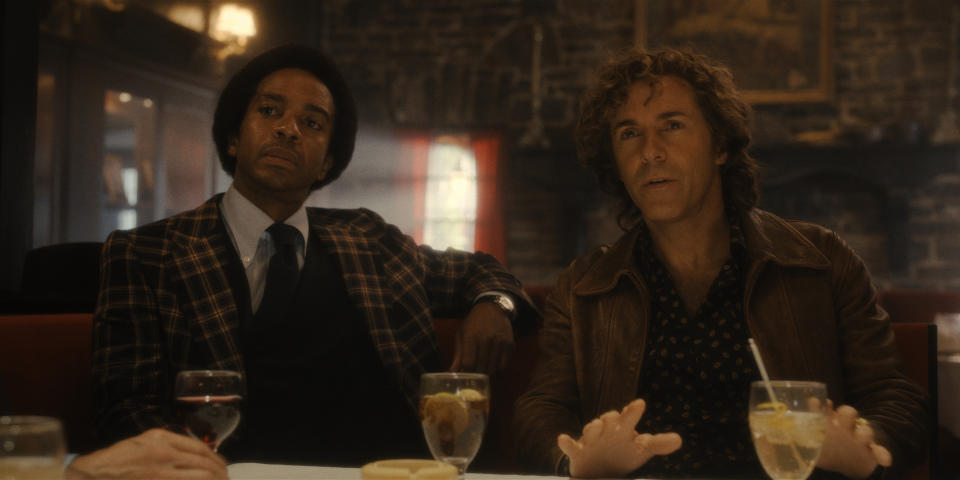The True Story Behind The Big Cigar

- Oops!Something went wrong.Please try again later.
- Oops!Something went wrong.Please try again later.
André Holland as Black Panther leader Huey P. Newton in "The Big Cigar," premiering May 17, 2024, on Apple TV+. Credit - Apple TV+
Fifty years ago, talks began for a movie inspired by real Hollywood bigwigs who helped a leader of the Black Panthers flee America. It never got made…until now.
The Big Cigar, a series debuting on Apple TV+ on May 17, is based on Hollywood producer Bert Schneider’s effort to get the black power group’s co-founder Huey Newton to Cuba, running the operation like a fake Hollywood movie production he called The Big Cigar.
The six-episode series follows Newton (André Holland) as he tests Schneider (Alessandro Nivola) to make sure he can be trusted before trusting him with his life. Below is a look at the real history that inspired the show.
Who are the Black Panthers?
Huey P. Newton and Bobby Seale founded the political organization known as the Black Panther Party in Oakland, California, in 1966.
The organization began as an effort to combat police brutality, putting its members on patrol on the streets where minority communities lived, as a type of self-defense. It also served those communities through free breakfast programs and free medical clinics offering preventative care in 13 cities nationwide. Dramatizations of these programs can be seen throughout The Big Cigar.
At the height of the Cold War, many free services were seen as supporting communist ideals. The Black Panthers faced extra scrutiny for this, and for their overall appearance: Members dressed in all black, while some were armed to protect their fellow community members, and the visibility of the guns sparked fears that they would become violent. The Black Panthers also faced constant FBI surveillance.
Huey P. Newton’s great escape
After co-founding the Black Panther Party, the organization made international headlines when Newton was involved with a shootout with Oakland police that left one officer dead, and Newton was charged with murder and sent to prison—sparking “Free Huey” rallies worldwide. By the time he met Hollywood producer Bert Schneider in September 1970, Newton had been released on bail. Schneider, riding high on the success of his film Easy Rider (1969) and TV series The Monkees (1966-1968), had been backing a bunch of various left-wing political causes, and began bankrolling the Black Panthers. “He realized the power that culture played in shaping ideas,” Joshuah Bearman, an executive producer of The Big Cigar, wrote in the 2012 Playboy magazine article that inspired the series. “Hollywood figures were helping to raise money for the Panthers.”
Sporting a Black Panther ring and proudly displaying a photo of him and Newton behind his desk in his office, Schneider (who also had a reputation for a serious cocaine addiction) wouldn’t hesitate to write checks to the organization for $10,000. The money went towards community programs and a penthouse in Oakland that served as a headquarters for the group. In fact, he once wrote a check for $250,000 to fund Black Community Survival conferences. As Bert described his fascination with Newton, “How can I put it? He’s my hero.”
But paranoia about the Black Panthers’ activities reached an all-time high on July 30, 1974, when Newton was arrested after a run-in with two police officers at a bar in Oakland. Six days later, Newton knew he had to get out of the U.S. somehow, when he was falsely accused of killing a 17-year-old prostitute. He sought refuge in the Bel Air home of Schneider’s friend Steve Blauner. Referring to themselves as the Beverly Hills 7, Schneider and a group of his Hollywood chums plotted to get Newton to Cuba where he could seek political asylum. As Bearman wrote in Playboy:
But paranoia about the Black Panthers’ activities reached an all-time high on July 30, 1974, when Newton was arrested after a run-in with two police officers at a bar in Oakland. Six days later, Newton knew he had to get out of the U.S. somehow, when he was falsely accused of killing a 17-year-old prostitute. He sought refuge in the Bel Air home of Schneider’s friend Steve Blauner. Referring to themselves as the Beverly Hills 7, Schneider and a group of his Hollywood chums plotted to get Newton to Cuba where he could seek political asylum. As Bearman wrote in Playboy:

“The Big Cigar” stood for Cuba. Schneider nicknamed Newton “the Star” and dubbed Artie Ross, a recent college graduate who worked for him, “the babysitter” because he had a boat that was supposed to take Newton to Cuba. One of the most helpful sources for Bearman was Newton’s account of the plot, which he found at Stanford University.
First, Newton needed to get Mexico. Blauner, who liked to gamble, called his bookkeeper to place some bets so it looked like he was just spending the day gambling, and then drove Newton to the U.S.-Mexico border. “I did everything I had ever seen in those movies,” recalls Blauner, in Peter Biskind’s Easy Riders, Raging Bulls: How the Sex-Drugs-and-Rock 'N Roll Generation Saved Hollywood. “This was the first thing that I could think of that I had ever done under conditions of life and death…for only one reason, the love of another human being.”
Read More: Black Panthers Meet New Hollywood in the Bold, Thrilling Series The Big Cigar
Ross was supposed to sail through the Panama Canal, pick up Newton in Mexico and then continue on to Cuba. Despite new radar and sonar equipment purchased by Schneider for the journey, the boat ran aground after hitting an underwater statue of Jesus in the Florida Keys that’s a popular snorkeling destination. The boat was in no condition to transport Newton all the way to Cuba, so Ross hitchhiked to Miami eventually made his way to Newton in Jalapa, a hideaway on the west coast of Mexico that Bert and a few other big kahunas bought in 1968 in case they wanted to flee when Nixon became President. A captain nicknamed “Pirate” was tracked down, chosen because he had a lot of experience going back and forth between Colombia and Mexico. Schneider agreed to make the captain whole for the boat if it got confiscated. The journey to Cuba was smooth sailing until the dinghy that Newton and his wife Gwen Fontaine needed to get to shore capsized. Fontaine saved Newton’s life by dragging him ashore.
What happened to the Big Cigar characters?
At some point in late 1974 or early 1975, Ross recounted the wild story in a script, titled The Big Cigar.
Newton liked it and gave Schneider the green light to shop it around. Though Warner Brothers and Richard Dreyfuss expressed interest in being involved, the film never got made. In 1975, Ross died from an overdose after inhaling too much laughing gas. Schneider built a shrine to Ross and threw a wake for him in the sauna room of his house that was attended by stars like Jack Nicholson, Warren Beatty, and Roman Polanski, according to a 2011 Los Angeles times obit for Schneider.
In 1975, Schneider appeared onstage to accept an Academy Award for his documentary Hearts and Minds about the Vietnam War, which he saw as vindication that political topics could be moneymakers. But he struggled the rest of his life with addiction and died in 2011.
Newton spent three years in exile in Cuba—cutting sugarcane and repairing trucks. Schneider visited him there, along with Hollywood stars Candice Bergen and Francis Ford Coppola. When Newton finally returned to the U.S., in 1977, he was acquitted of charges of assault and murder. About a decade later, in 1989, he was fatally shot by an Oakland drug dealer.
As for Newton and Schneider’s friendship, it remained close until Newton’s death. As Bearman put it to TIME in a recent phone conversation, “They stayed in touch. They would see each other. It's what you now would call a ‘bromance.’”
Write to Olivia B. Waxman at olivia.waxman@time.com.

